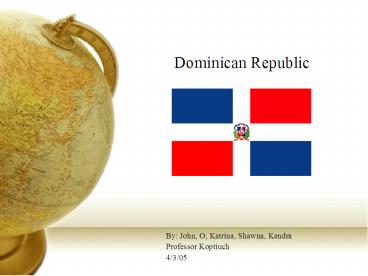Dominican Republic - PowerPoint PPT Presentation
1 / 25
Title:
Dominican Republic
Description:
In 2004 Dominican Republic joined the CAFTA (Central American Free Trade Agreement) ... the same racial prejudice as the African Americans experienced. ... – PowerPoint PPT presentation
Number of Views:987
Avg rating:3.0/5.0
Title: Dominican Republic
1
Dominican Republic
- By John, O, Katrina, Shawna, Kendra
- Professor Koptiuch
- 4/3/05
2
Overview
- Population 8.6 million
- Language Spanish
- Location Central Caribbean
- Government Representative
- Democracy
- Currency Pesos
- Economy 16 Billion
- Per Capita GDP 1,896
3
Top Countries of Migration
- United States
- New York
- Miami, Florida
- Puerto Rico
- San Juan
- Spain
- Madrid
- Italy
- France
4
Brief Why Migrants Leave Dominican Republic
- So, why leave the Dominican Republic for the U.S.
and Puerto Rico? Well, this could have something
to do that fact that 65 of the trade industry in
the Dominican Republic is done with the U.S. and
Puerto Rico (www.washdiplomat.com). This makes
an instant connection to the U.S. and Puerto Rico
with the Dominican Republic. Perhaps another
reason people choose to leave the Dominican
Republic was due to the political climate. The
1961 ended a 31-year dictatorship, the worst the
Dominican Republic had ever seen. In that year,
Rafael Leonidas Trujillo Molina was assassinated.
Finally after 3 decades, there came an end to
the killing of Haitians as well as Dominicans.
The idea of living in a democratic society with
freedom of speech, was and still is a Dominican
Republic, which continues to bring new people,
culture and traditions to our ever-changing
society.
5
Why Migrants Leave Dominican Republic
- After 1960s migrants left because of political
instability. - Dominican revolution ended in the 1960s
- Dominicans were not satisfied with their leader
Trujillo. - In the 1970s 56 of Dominican immigrants arrived
in the United States. - In the 1980s immigration soared.
- In 1990-1993 immigrant population doubled in the
United States.
6
Why Migrants Leave Dominican Republic
- Three main reasons for modern migration.
- Poverty, Unemployment, Free Trade
- Poverty
- 21-27 population live in poverty (monthly income
US 60) - 11-30 population live in an indigenous situation
(monthly income US 30) - Unemployment
- 6.1 of total population are unemployed.
7
Why Migrants Leave Dominican Republic
- Free Trade
- In 2004 Dominican Republic joined the CAFTA
(Central American Free Trade Agreement) - No tariffs are charged to the companies that
produce or ship there goods to other countries. - Companies offering low paying jobs to the people
in the island. - Putting smaller companies out of business.
8
Family Lifestyle in Dominican Republic
- Large families
- Non-nuclear
- Male controls household
- budget has final authority
- over family members
- Females are responsible for domestic tasks and
maintenance - National pastime is Baseball
9
Self Sacrifice
- While Dominican migrants are here in the U.S.,
living and working, they are sending remittances
to their family and loved ones in their homeland.
As a result, this is clearly very beneficial to
those back home. Some even make an annual trip
to the U.S. to raise money for the parish. In
2002, the Dominican Republic received over two
billion dollars in remittances. - Migrated Dominicans still return to their
homeland - This causes a spark in many business
opportunities like - Apartments
- Discos
- Schools
- Community
10
Tensions Within Families
- Dominican residents criticize Dominican migrants
as - Foreign
- un-Dominican
- Dominican migrants are embracing the culture of
their ADOPTED land - Dominican Family role has changed because of the
following - Smaller Families
- More Nuclear
- Females have more control over budget and have
some authority from their husbands - Co-breadwinners now
- Education is very important
11
Migrants Politicization
- Employed in low-wage, low prestige jobs
- Little job security or protection while on the
job - Majority work in manufacturing, restaurants, and
hotels - Reasons language barrier, discrimination,
illegal status or many in the community, and the
lower level of education - Because of the mixed Afro-Hispanic heritage of
many Dominicans they encountered the same racial
prejudice as the African Americans experienced.
12
Migration Information SourceChart
13
Migration Information SourceChart
14
BriefReceiving Countries
- The U.S. has the largest and most
technologically powerful economy - in the world, with a per capita GDP of 37,800
(www.cia.gov). This - may seem as though were doing well, and some
are, while others are - not so lucky. When the details of life are taken
into consideration, - such as interest rates, health care and the
numbers of people in a - household, then these numbers begin to change.
Now think of the per - capita in Puerto Rico, 8,500 (www.englishfirst.co
m). Suddenly the - U.S. per capita income is looking better, even
with all of the expenses - we experience in todays society. Now, lets take
all of this information - one step further. The Dominican Republic has a
per capita income of - 2,200 (www.washdiplomat.com). What some people
make in one - month in the U.S. is what others make one year.
Obviously the cost of - living is quite different however it is all
relative to ones experience.
15
Percentages of Receiving Countries
- The Dominican Republic is a source of incoming
migrants primarily to the United States and
Puerto Rico. During the 1980s, there was
roughly 300,000 to 800,000 Dominican migrants
living and working in the U.S. While another
200,00 were in Puerto Rico. The popular
destination for these migrants started of being
New York, however over time, the entire east
coast has been receiving Dominicans. Working in
the United States has become almost an expected
part of the lives of Dominicans from families of
moderate means (http//loc.gov). - 8-15 of the Dominican population immigrants to
different countries - 6.9 of the foreign-born Dominicans occupy the
upper white-collar jobs - 33.5 occupy the lower white-collar positions
16
Receiving Countries
- Most immigrants from Dominican Republic arrived
by boat to Puerto Rico - Then from there they wait to come to the US.
- Per capita income is about 150 per week.
- According to the Department of Homeland Security
(DHS), legal immigration in fiscal year 2003 from
Dominican Republic was 26,205 - 300,000 Dominican were undocumented in the US.
17
Receiving Countries Continued..
- A guest worker program was introduced in January
2004. - The goal was to increase the number of permanent
immigrants. - Permanent citizenship is possible for immigrants
- Through family sponsored immigrants
- And employment-based preference immigrants.
18
Receiving Countries Continued.
- Multicultural, which implies that immigrants
should be granted equal rights in all spheres of
society, without being expected to give up their
diversity.
19
NEWS FLASH
- HEADLINE
- Record Immigration Changing New York's
Neighborhoods - BYLINE By NINA BERNSTEIN
- At a time when a Congressional push for
crackdowns on illegal - immigrants is converging with backlogs in legal
immigration, the - report stresses the economic benefits that sheer
numbers of - newcomers brought the city in recent decades,
replacing residents - who died or moved out, filling housing vacancies,
revitalizing small - businesses, and now accounting for 43 percent of
the city's work - force. High rates of migration to other states
are still offset only - by a combination of foreign immigration and
births increased by - immigrant fertility, the demographers said.
20
Sources
- http//loc.gov
- www.cia.gov
- www.englishfirst.com
- www.washdiplomat.com
- www.washdiplomat.com
- www.migrationinformation.org/GlobalData/countrydat
a/data.cfm - www.migrationinformation.org/Profiles/display.cfm?
ID283 - Gale Ency. Of Multicultural America Vol.1 P.431.
- Gale Ency. Of Multicultural America Vol.1 P.431.
- Gale Ency. Of Multicultural America Vol.1 P.428.
- CRS Report for CongressUS Immigration Policy on
Permanent Admissions, Feb 2004. - http//0-web.lexis-nexis.com.library.lib.asu.edu/u
niverse/document?_m7706a22a3ba612d07b63bef73060fd
ee_docnum12wchpdGLbVlb-zSkVA_md5f3e5676a3553
6b39f7cb2ae6dbe102fb - Castles, Stepen Mark J. Miller,The Age of
Migration, 1998(2nd Ed.)Macmillan Press - http//reference.allrefer.com/country-guide-study/
dominican-republic/dominican-republic33.html
21
Impact of Migration on Dominican Republic
- Total remittances from U.S., Puerto Rico, and
Europe exceed 3.75 billion in 2003. - 2.7 billion (77 of total) from U.S. Average is
1,500 to 2,000 per person in D.R. from U.S. - Average total yearly income for D.R. is 3,500.
Remittances make up almost half of income. 60
of remittances used to pay bills and survive.
Also used to finance local businesses and to
purchase land. - Most migrants view remittances back to family as
an obligation. Those who refused to send
financial support come under severe criticism
from fellow migrants and those remaining in D.R.
22
Impact of Migration on Dominican Republic
- Unemployment rate in D.R. is high and most local
jobs are very low pay. Social clubs and
associations in New York host fundraising events
for public works projects in villages and small
towns in D.R. These provide construction jobs
and semi-permanent jobs for locals. - Tourism is number one industry, followed by
manufacturing free zones and remittances. On
holidays such as Christmas, Holy Week, and
Dominican Mothers Day, the island is flooded
with immigrants who fly back to D.R. to visit
with family. Tremendous impact on local
economies and aid in job creation for retail
stores and service businesses.
23
Impact of Migration on Dominican Republic
- Migration impacts family and social structure. A
Cibao village reported that 85 of households had
at least one member living in New York in
mid-1970s. In many villages 18 to 45 year old
males were essentially missing. Lack of males
restricts choices for leadership roles in local
communities. - Older women immigrants to U.S. outnumber older
men more than two to one. Grandmothers recruited
to take care of young grandchildren while mothers
work - Out-migration impacted brain drain and local
loss of skilled and unskilled workers
24
Impact of Migration on Dominican Republic
- Migrants to U.S. in 1960s had a lower
naturalization rate than the second generation of
U.S. born. A higher percentage of the first
generation migrants wanted to eventually return
to D.R. - Naturalization rates have steadily increased
since 1980s. It is likely that smaller
proportion of this second generation will decide
to resettle in the D.R. Most speak English and
relate with African-American culture. - This trend will have impact on transnationalizatio
n and support of local D.R. cultural practices in
the U.S. community. - The political and economic instability of D.R.
influences decision to visit and even whether to
return to D.R.
25
Sources for Burnett
- Banco Interamericano de Desallarollo
www.iadb.org/NEWS/Display/PRView.cfm?PR_Num246_04
Lan - American Immigrant Cultures, Volume 1, pp 223,
224, 226, 227. Simon Schuster, 1997 - U.S. Department of State, Bureau of Western
Hemisphere Affairs, March 2005, p 5. - Library of Congress Country Studies Dominican
Republic, December 1989, page 2. - World Trade Organization, Dominican Republic
February 1998, pp 1-4.































